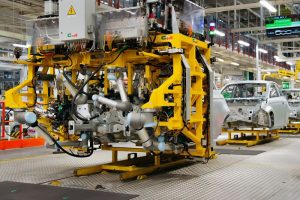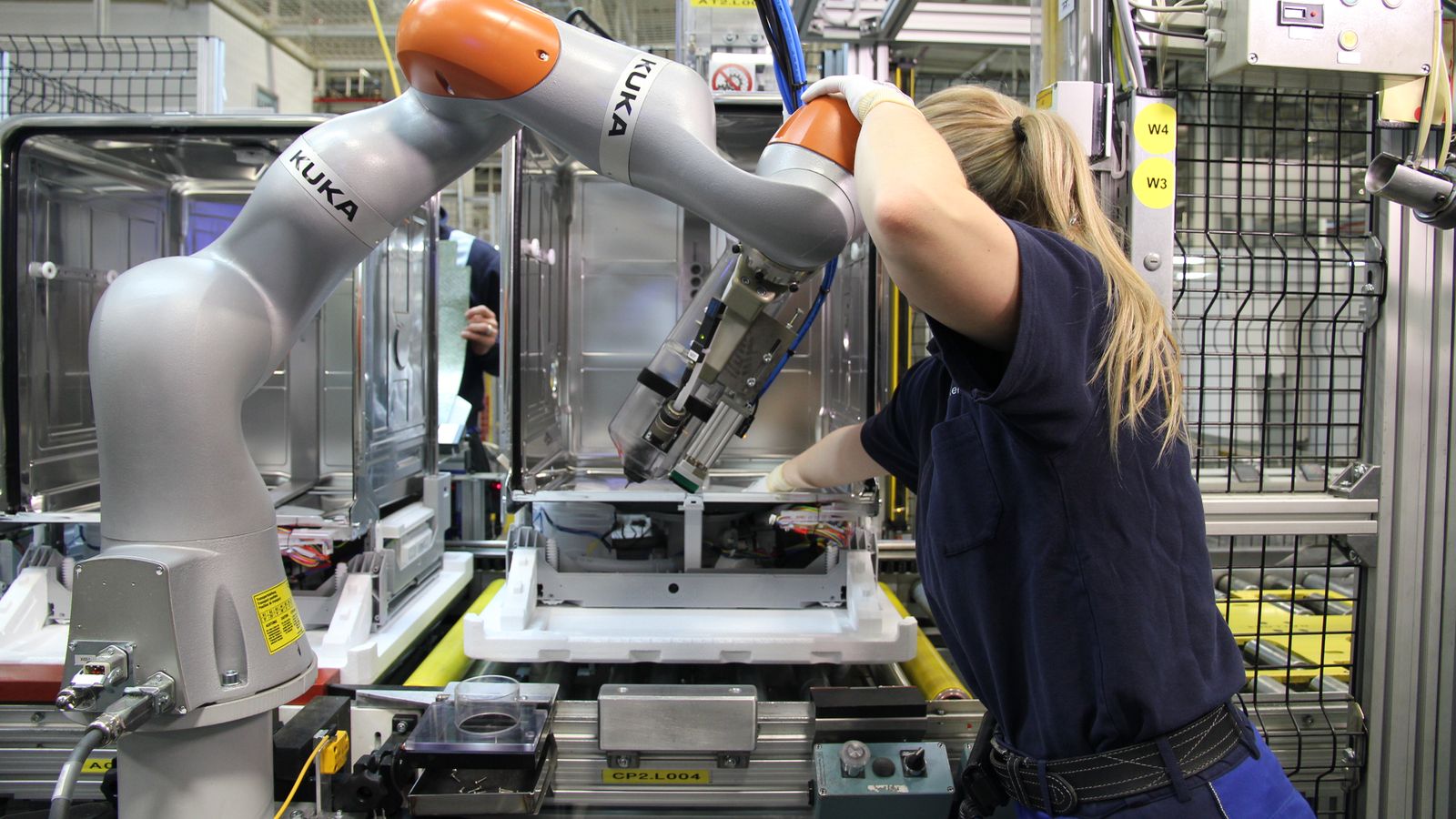The introduction of robotics and automation was one of the main changes the industrial revolution brought about in the manufacturing sectors.
They were released onto the market to boost output and cut costs. Robots may now be programmed and controlled to carry out complex tasks with the help of artificial intelligence.
For example, applications for robots in manufacturing include product packaging, raw material processing, shipping, welding, and assembling.
Now, you might be wondering if robots are costly for your industry. Alternatively, is your company too tiny to employ robots?
Are programming and using factory robots complex tasks? Will it result in the employment loss of human workers?
As mentioned earlier, the answer to each of the questions is NO.
Let us look at the origin of robots in the manufacturing industry.
The Beginning of Robotics in the Manufacturing Industry (1938-1979)

The first industrial robots were developed thanks to the introduction of numerically controlled machinery and the growing acceptance of computers.
Griffith “Bill” P. Taylor developed the first industrial robot that complied with the ISO definition of the term in 1937. It was made of Meccano pieces and resembled a crane.
It featured a single electric motor. Grabs and rotations make up two of its five axes of motion. The robot could place wooden blocks in specified patterns and was mechanized using paper tape with holes punched to activate solenoids.
The first industrial robot patent was submitted in 1954 by George Devol. His robot could move objects up to 12 feet away from one another.
To work on the development of the robot, he formed Animation in 1956 and coined the phrase “universal automation.”
In 1962, General Motors used UNIMATE, a robot developed by Unimation, as its first employee. Victor Scheinman created Stanford’s arm in 1969 at Stanford University—a 6-axis, all-electric, articulated robot.
This new technology allows manufacturers to use robots for welding and assembly jobs. ASEA in Europe created the ASEA IRB, a robot entirely driven by electricity, in 1975.
It was also the first robot to employ a microprocessor controller and an Intel chipset. In 1981, Takeo Kanade developed the initial robotic arm with joint-mounted motors. It was much faster and more precise than its predecessors.
The first collaborative robot (cobot) was installed by Linatex in 2008. A Danish rubber and plastics manufacturer placed the robot on the ground instead of keeping it behind a safety barrier.
They may program the robot via a touchscreen interface, saving money for hiring a programmer. It was instantly clear that this was how things would proceed moving forward.
We may not exhaust the list of robotics innovations, but these are some of the significant ones initially.
Read Also: The future of transportation:self-driving cars and the rise of AI.
How is Robotics used in the Manufacturing Industry?
Nowadays, robots and people (cobots) work together on practically all tasks. For example, robotics are used in manufacturing to automate repetitive operations and speed up assembling.
However, many industries entail complex, risky jobs that might harm human workers. Additionally, working long hours might make people tired and inattentive, which could result in mishaps or mistakes.
However, due to their advanced machine-learning capabilities, manufacturing robots cannot aid these sectors in eradicating such errors.
The Tesla Gigafactory, one of the most state-of-the-art factories ever constructed, features autonomous self-navigating cars with unfettered movement to carry commodities between workstations.
Robotic process automation (RPA) is a developing technology with numerous industrial applications. Such robots can mimic human thought processes, speed up work, and alter business procedures.
Technology may act as an additional employee in several supply chain areas, working in collaboration with back-office operations and IT systems to efficiently accomplish time-consuming tasks like processing purchasing management orders and invoices.
According to a Capgemini study, 84% of RPA users said robotics might significantly reduce costs, while 91% of respondents said RPA might help businesses save time on repetitive tasks.
That is only one of several factors that point to a bright future for robot use in manufacturing. This sector will require sophisticated robots worth $3.7 billion by 2021.
5 Benefits of Using Robotics in Manufacturing
The most apparent advantage of robotics is safety. A person might readily get wounded by using heavy machinery, hot machinery, and sharp objects.
Giving riskier tasks to a robot increases your likelihood of facing a repair bill rather than a large medical bill or legal trouble. In addition, workers who perform complex tasks will value robots’ ability to reduce some risks.
1. Speed
Robots don’t need breaks and can become distracted quickly. They don’t ask for an extra day off or leave sooner. A robot is incapable of feeling nervous and slowing down.
Furthermore, inviting them to staff meetings or training sessions is unnecessary. Robots speed up manufacturing since they can work continually.
They save your personnel from straining themselves to exhaustion trying to meet strict deadlines or impossible standards.
2. Consistency
Robots do not need breaks and are easily distracted. They do not request a day off or leave an hour sooner. A robot can never feel worried and start moving slowly.
They are also not obligated to attend staff meetings or training sessions. Robots accelerate manufacturing because they can function continually.
They keep your employees from overworking themselves to meet impossible deadlines or standards.
3. Perfection
A robot will always succeed in delivering excellence. Moreover, they are less prone to errors since they are intended to move accurately and frequently.
In specific ways, robots function as both a quality assurance system and an employee. The lack of preferences and quirks and the elimination of human errors will always result in a consistently faultless output.
4. Happier Employees
Because robots usually undertake duties that people dislike, such as menial labor, repetitive motion, or dangerous work, your workers are more likely to be satisfied.
As a result, employees can instead concentrate on more complicated activities or professions requiring a human touch and inventiveness.
Read Also: The Impact of AI On The Future Of Work
5. Productivity
Robots cannot do all tasks. A person can only complete specific jobs. If your human employees are focused on activities that computers could do, they’ll be more available and productive.
They can connect with customers, react to emails and social media comments, aid with branding and marketing, and sell products. When the drudge job no longer holds them back, you’ll be surprised at how much they can accomplish.
What kinds of robotic machines are used in manufacturing?
Articulated Robots
Rotating joints in this robot design range in number from two joint structures to at least ten joints. Every industrial robot’s arm, which is joined to the base by a twisted joint, is its most crucial component.
Rotating joints represent the connections to the arm. The increased range of motion that each joint in an articulated industrial robot enables is one of its benefits.
These robots are employed due to their adaptability and aptitude for performing jobs.
Cartesian Robots
Three linear joints of this type, also called a gantry or rectilinear robot, are supported by the Cartesian facilitation system. This industrial robot also has an extra wrist for the arm’s rotational development.
Three kaleidoscopic joints are used in a Cartesian industrial robot to pursue linear movement (along the axis). Industrial robots of this kind may seal, stack, exchange tools, and move items, among other things.
Cylindrical Robots
A barrel-shaped region is occupied by one or more hollow, spherical robots joined at the base. This is so that rotary joints—which require rotational motion—can function like a kaleidoscope, which operates in a linear motion.
Artic Robots
Another name for these machines is spherical robots. The arm of Polar industrial robots is connected to the base utilizing a rotary joint and a mix of rotary (2) and linear (1) joints.
The industrial robot gets its name from the polar coordinate system, or range of motion. They are employed in manufacturing to reduce production costs, boost output, and lower mistakes.
Read Also: The latest advancements in robotics and automation
5 Industries in the manufacturing sector that use robotics
1. Automotive
Robotic automation has been utilized in automobile assembly product and line testing for over 50 years and has substantially impacted the industry.
To increase output, human workers and robots cohabit in many car factories. Since robots are more adaptive than people and don’t need breaks, they can do repetitive tasks more quickly and precisely.
2. E-machine Manufacturing
The continued demand for electronics like flat-screen TVs, cell phones, and other devices allows manufacturers more freedom to add automation.
These robots can increase production levels on industrial floors without taking up more priceless space. Cobots have been used in this area primarily due to their adaptability in handling duties and ability to work alongside people.
3. Medical
The growth of robotic automation has greatly benefited the medical industry. Nowadays, robots help doctors do precise treatments.
In one instance, a surgical semi-autonomous robot performed better than human surgeons with greater precision and less damage to the surrounding tissue.
In addition, robotic accuracy can guarantee higher success rates in delicate medical procedures where even the flow of blood through a surgeon’s fingertips could affect the accuracy of a system.
4. Food Manufacturing
Robotics in the food and beverage business aids in improving product quality by using machine vision cameras, sensors, processing hardware, and software algorithms to find defects in the production process.
Much consumer safety and more consistently high-quality food products are the results.
5. Agriculture
Agriculture has embraced robotics to increase output while lowering costs. Thanks to sensor technologies, farmers can monitor diseases and pests that hurt crop yield.
Automated solutions are becoming increasingly popular for weeding, spraying, and trimming.
Robotics in Manufacturing: The Future
Today, robotics is used in manufacturing across a wide range of sectors. Like other sectors, the robotics industry has suffered from the COVID-19 impact. However, this does not indicate that the industry has ended.
Robotics and automation have been increasingly important for businesses to reduce human contact and stay competitive.
Most robotic spending is on manufacturing robots, which have profited from the pandemic’s effects.
Industrial robots typically operate independently of people and other machines.
However, thanks to technological advancements, collaborative robots can be used in the workplace alongside people without any safety barriers.
Researchers are working to develop collaborative robots that can complete tasks from beginning to end.
The future will change in the upcoming years due to robots. Robotics’ use in manufacturing has significantly impacted how products are produced, assembled, and packaged.
Impacts of Robotics on the Manufacturing Industry
Here are some of the effects of robotics on the manufacturing industry, along with instances and statistical proof:
Increased efficiency
Robotics has made manufacturing processes faster and more efficient. Robots can work 24/7 without fatigue, increasing production and reducing lead times.
For instance, in the automotive industry, robots are used to weld, paint, and assemble cars, significantly reducing production time.
According to a report by the International Federation of Robotics, global sales of industrial robots increased by 11% in 2020, with 373,000 units sold.
Improved quality
Robots can perform repetitive tasks with high accuracy, reducing the chances of errors and defects. This has resulted in improved product quality and reduced waste.
For example, robots package products with precision in the food and beverage industry, reducing waste and improving quality.
Reports by Allied Market Research, the global food robotics market is expected to reach $3.35 billion by 2025, growing at a CAGR of 13.0% from 2018 to 2025.
Increased safety
Robotics has made manufacturing processes safer for workers by taking over dangerous tasks. This has reduced the number of workplace accidents and improved workers’ overall security.
For instance, in the pharmaceutical industry, robots handle hazardous chemicals and perform tasks that could expose workers to harmful substances.
Reports have it that robotics in the workplace can reduce worker exposure to hazards by up to 85%.
Reduced labor costs
Robotics has reduced the need for human labor in manufacturing, resulting in lower labor costs. This has enabled companies to remain competitive by reducing their production costs.
For example, in the electronics industry, robots are used to assemble circuit boards, reducing the need for manual labor.
According to a report by the International Federation of Robotics, using robots in the manufacturing industry can reduce labor costs by up to 16%.
Increased flexibility
Robotics has made it possible to produce more products and quickly respond to changing market demands.
This has enabled companies to remain competitive and adapt to changes in the marketplace.
For instance, in the consumer goods industry, robots label products of different sizes and shapes, allowing companies to produce various products without changing product lines.
Grand View Research states that the global robotics market in the consumer goods industry is expected to reach $14.7 billion by 2025, growing at a CAGR of 10.2% from 2018 to 2025.
Conclusion
In conclusion, the impacts of robotics on the manufacturing industry have been significant, resulting in increased efficiency, improved quality, safety, reduced labor costs, and flexibility.
The statistics and examples above demonstrate the widespread adoption of robotics in the manufacturing industry and its potential to transform how products are produced and consumed.

